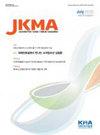肺周围病变的诊断:经支气管活检采用桡骨探头支气管内超声
IF 0.5
Q3 MEDICINE, GENERAL & INTERNAL
引用次数: 0
摘要
背景:桡骨探头支气管超声(RP-EBUS)已被用于诊断周围性肺病变(PLLs)。我们回顾了传统的使用RP-EBUS的经支气管活检方法以及最近在提高诊断率方面的进展。目前的概念:到目前为止,在RP-EBUS过程中,pll的钳活检在获取组织样本方面发挥了关键作用。钳活检是一种安全且微创的手术;然而,据报道其诊断率约为70%,明显低于经皮穿刺或活检。到目前为止,已经进行了各种研究来提高RP-EBUS程序的诊断率。新型导航系统的结合,如虚拟或电磁导航支气管镜,用于定位复杂支气管树中的pll,提高了RP-EBUS程序的诊断率。此外,新开发的辅助设备,如PeriView FLEX针或冷冻活检,以及传统的方式,如引导鞘和刷细胞学,可以改善RP-EBUS手术的结果。关于支气管镜的大小,已经证实3mm直径的超薄支气管镜比4mm直径的超薄支气管镜具有更高的诊断率。讨论与结论:RP-EBUS是一种安全、有效的pll诊断方法。当传统和新的模式适当结合,诊断率可以提高。本文章由计算机程序翻译,如有差异,请以英文原文为准。
The diagnosis of peripheral lung lesions: transbronchial biopsy using a radial probe endobronchial ultrasound
Background: Radial probe endobronchial ultrasound (RP-EBUS) has been used in the diagnosis of peripheral lung lesions (PLLs). We reviewed the traditional modality of transbronchial biopsy using RP-EBUS as well as recent developments in improving the diagnostic yield.Current Concepts: Until now, the forceps biopsy of PLLs has played a key role in acquiring tissue samples during the RP-EBUS procedures. Forceps biopsy is a safe and minimally invasive procedure; however, its diagnostic yield was reported to be around 70%, which is significantly lower than that of percutaneous needle aspiration or biopsy. So far, various studies have been conducted to improve the diagnostic yield of the RP-EBUS procedure. The combination of novel navigation systems, such as virtual or electromagnetic navigation bronchoscopies, for locating PLLs in the complex bronchial tree has increased the diagnostic yield of the RP-EBUS procedure. Moreover, newly developed ancillary devices, such as the PeriView FLEX needle or cryobiopsy, as well as traditional modalities such as the guide sheath and brushing cytology, can improve the outcomes of the RP-EBUS procedures. Concerning the bronchoscope size, it has been confirmed that a 3 mm-diameter ultrathin bronchoscope has a higher diagnostic yield than a 4 mm-diameter thin bronchoscope.Discussion and Conclusion: RP-EBUS is a safe and useful method to diagnose PLLs. When traditional and novel modalities are appropriately combined, the diagnostic yield can be increased.
求助全文
通过发布文献求助,成功后即可免费获取论文全文。
去求助
来源期刊

Journal of The Korean Medical Association
Medicine-General Medicine
CiteScore
0.50
自引率
0.00%
发文量
84
审稿时长
4-8 weeks
期刊介绍:
The Journal of the Korean Medical Association (JKMA) is the official peer-reviewed, open-access, monthly journal of the Korean Medical Association (KMA). It contains articles in Korean or English. Its abbreviated title is ''J Korean Med Assoc''. The aims of the Journal include contributing to the treatment of and preventing diseases of public health importance and to improvement of health and quality of life through sharing the state-of the-art scientific information on medicine by the members of KMA and other national and international societies.
 求助内容:
求助内容: 应助结果提醒方式:
应助结果提醒方式:


